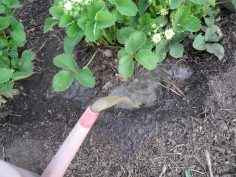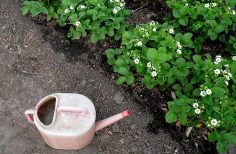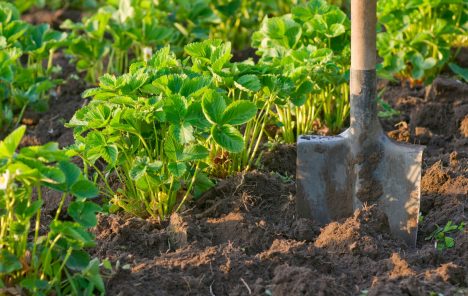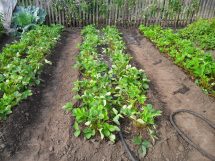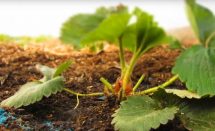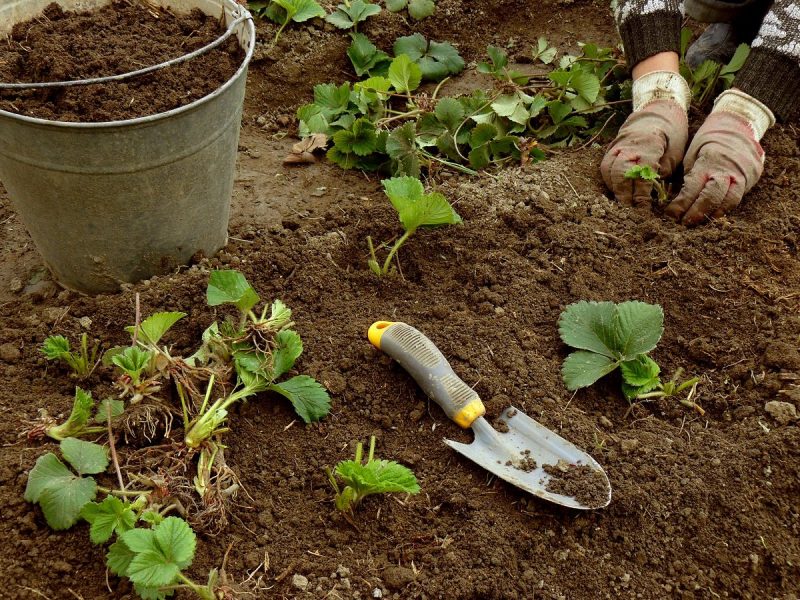Experienced gardeners know how to process strawberries in the spring in order to later harvest a good berry crop. Plants need protection from diseases and pests, in the proper feeding. In the article you will find tips on how to determine the lack of nutrients, how to fertilize and protect strawberry beds.
Material Content:
Features of processing strawberries in the spring
The first thing to do when the snow comes down is to remove the dry and stained leaves from the strawberries, cut off the mustache that appears so that more berries are tied. Then loosen the earth around the bushes, fall asleep with mulch.
In dry weather, strawberries need to be watered by adding fertilizer to the water. It is good to use humic top dressing, which stimulate root growth, for example, Gumi-Omi berry.
In spring, strawberries need treatment from pests and diseases. Unfortunately, they are present in any area, so preventive spraying is carried out before flowering and fruiting. For example, a tick is able to breed up to 20 new generations in one season. If you do not prevent its spread, the crop can not be seen.
Biological preparations for spraying in early spring are not suitable, since they are ineffective if the air temperature is below 18 ° C.
They can be used at the end of May or in the summer.
The better to treat plants from typical diseases
Plants in the spring are treated with broad-spectrum fungicides in order to immediately get rid of most dangerous pathogens.
The main diseases of strawberries:
- powdery mildew;
- brown spotting;
- gray rot;
- verticillus wilting;
- Fusarium
With verticillus and fusarium wilting, strawberries look as if they lack watering. The leaves begin to dry out and the plants soon die. The infected strawberry bushes need to be dug up together with a lump of earth and burned. Shed the released bed with a fungicide solution.
If the weather is cold, use chemicals - Maxim, Vitaros, Fundazol, copper sulfate. It must be remembered that these drugs are incompatible with biological fungicides.
For the prevention of various fungal diseases, it is convenient to use biological preparations:
- Trichocin - on the basis of the beneficial fungus Trichoderma, it suppresses pathogenic microflora in the soil, acts on root pathogens.
- Trichoplant - also based on trichoderma, protects strawberries from black legs, late blight and other fungal diseases, suitable for root and foliar treatment.
- Fitosporin - biologically active drug, helps in the fight against fungal diseases, safe for people and animals.
Together with biofungicides Ecomic Harvest can be used. It contains in concentrated form microorganisms that increase soil fertility. Lactobacillus and bacillus in its composition contribute to the rapid decomposition of organic substances in the ground, making them available to plants.
Straw pests and control
Before planting, it is advisable to soak for 10-15 minutes strawberry seedlings in hot water at a temperature of 60 ° C.
Dip the bushes in boiling water completely, together with the leaves, so that the pests die.
This will protect new plantings from problems and premature degeneration.
It is interesting:garden yeast fertilizer
The main pests of strawberries:
- transparent strawberry tick;
- spider mite;
- strawberry and raspberry weevil.
It is easy to identify plants affected by a spider mite. If you look closely, you can see traces of cobwebs, deformed young leaves.
It is more difficult to see a strawberry tick, it is microscopic in size. Plants show signs of pest habitat. Young leaves acquire a special olive-yellowish color, do not bloom for a long time, the berries ripen small, dry.
Strawberries are also affected by strawberry-raspberry weevil. This small insect hides in the folds of leaves, so it is difficult to notice. When the strawberries begin to bloom, the female weevil lays eggs in unblown buds, where larvae develop. Lost up to 70% of the crop.
How to properly process strawberries
To prevent crop losses from strawberry-raspberry weevil, you need to accurately guess the processing time. This is best done when buds begin to set. In early spring, insects hide under the leaves and clods of the earth, and it is very difficult to destroy them. They process strawberries from weevils with an insecticide (for example, Spark).
To combat ticks, it is necessary to purchase acaricides, for example, Actellik, Fufanon. Having noticed several affected plants, they spray the entire bed of strawberries, because the mites will spread quickly. The spray should be small, large drops of solution will quickly roll off the leaves.
Experienced gardeners from strawberry mites also apply the thermal method.
To do this, the bushes are shed in the spring with hot water. Fluid temperature should not be lower than 55 ° C.
Fertilizers for a good harvest
Spring feeding strawberries is very important for the harvest. Having noticed spots on the leaves, gardeners immediately think that the plant is sick or damaged by a pest. But the reason for changing the color and shape of the leaves can be not only a disease, but also a lack of nutrients.
The plant itself can "tell" what it lacks. Fungal diseases are distinguished by round spots. Over time, the middle of such a spot falls out and a hole forms. If the leaves are damaged by the pest, insects can be seen when examined.
When plants look lifeless, lag behind in growth, it is worth suspecting that they are starving. Strawberries are the leader in nutrient intake from the soil. you need a lot of micro and macro elements.
To determine what exactly plants lack, you need to carefully consider them:
- If the leaves began to fade, and the bottom got a yellow color - strawberries not enough nitrogen, then it needs to be fed with urea. Since mid-July, nitrogen fertilizing can not be done.
- Phosphorus deficiency manifested during fruiting, berries grow tasteless and soft. With phosphorus starvation, the leaves become smaller, and acquire a reddish tint. To quickly feed the plants, a phosphorus extract is prepared - superphosphate is insisted for 2-3 days, the resulting liquid is watered with strawberries.
- Potassium deficiency appears on the upper side of old leaves, they turn red. At first, only the rim of the leaf blushes, and then the entire leaf plate. Potassium sulfate is used for top dressing.
To prevent signs of hunger, it is best to apply specialized fertilizer for strawberries in the spring, and monitor the plants during the season.
Strawberries also need trace elements, this is what happens when they are deficient:
- calcium deficiency - the leaves do not unfold, they can darken and die, you need to feed the plants with calcium nitrate;
- lack of magnesium - the edge of the leaf plate dries, the veins redden, use kalimag, kalimagnesia for the cortex;
- lack of boron - the leaves become corrugated, then dry, the flowers and fruits acquire an ugly shape, spray the plants with boric acid;
- lack of iron - the leaves turn pale, and the veins remain green, feed plants with iron chelate;
- copper shortage - with sufficient watering, the plants are sluggish; complex preparations with copper are used for treatment.
During the season you need at least 3 top dressings with complex fertilizers with macro- and microelements. This is important for a good strawberry crop, and resistance to various diseases.
Personal precautions when feeding and treating
Many chemicals that are used to treat plants from diseases and pests contain toxic substances.
To protect against the unpleasant consequences of poisoning, it is necessary to observe safety measures.
You need to work in special clothes, as well as an apron and sleeves made of film material. There should be rubber boots on the feet, rubber gloves with a knitted base on the hands. It is advisable to wear sealed safety glasses and a respirator.
During the work with agrochemicals it is forbidden to drink, eat, smoke. At the end of the spraying of the area, the hands and face should be washed with soap and rinse your mouth.
All work is carried out in calm, dry weather, at an air temperature of no higher than 24 ° C. If biological preparations having a 4th hazard class are used for processing, only rubber gloves will be needed from personal protective equipment.




